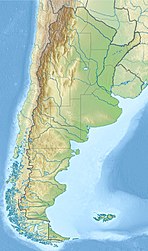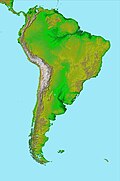Salta Basin
| Salta Basin | |
|---|---|
| Cuenca Salta | |
| Coordinates | 23°40′S 66°07′W / 23.667°S 66.117°W |
| Etymology | Salta Province |
| Region | Argentine Northwest |
| Country | |
| State(s) | Salta, Jujuy, Tucumán Potosí Antofagasta |
| Cities | Salta |
| Characteristics | |
| On/Offshore | Onshore |
| Boundaries | Andes |
| Part of | Andean foreland basins |
| Geology | |
| Basin type | Foreland-on-rift basin or intracontinental rift basin |
| Plate | South American |
| Orogeny | Andean |
| Age | Neocomian-Neogene |
| Stratigraphy | Stratigraphy |
Salta Basin or Salta Rift Basin is a sedimentary basin located in the Argentine Northwest.[1][2] The basin started to accumulate sediments in the Early Cretaceous (Neocomian) and at present it has sedimentary deposits reaching thicknesses of 5,000 metres (16,000 ft). The basin contains seven sub-basins: Tres Cruces, Lomas de Olmedo, Metán, Alemanía, Salfity, El Rey, Sey and Brealito. The basin environment has variously been described as a "foreland rift" and an "intra-continental rift". The basin developed under conditions of extensional tectonics and rift-associated volcanism.[1]
Description
The basin basement is composed of rocks belonging to the Puncoviscana Formation.[2] The volcanism that began in the Late Jurassic was initially of subalkaline character (low sodium and potassium content), but turned increasingly alkaline in the Early Cretaceous.[1]
The rifts of Salta Basin developed in a time of generalized extensional tectonics along western South America.[3] It has been proposed that the Salar de Atacama depression in Chile was once a westward rift arm of the Salta Basin.[4]
Stratigraphy
| Age | Group | Subgroup | Formation | Lithologies | Basin stage | Notes |
|---|---|---|---|---|---|---|
| Pliocene | Payogastilla | San Felipe | Conglomerates | Foreland | [5] | |
| Huayquerian | Jujuy | Piquete | [6][7] | |||
| Huayquerian | Guanaco Sonso | [8] | ||||
| Montehermosan | Palo Pintado | [9] | ||||
| Chasicoan | ||||||
| Laventan | Angastaco | [10][11] | ||||
| Friasian | ||||||
| Friasian | Metán | Jesús María | [11] | |||
| Friasian | Anta | [11] | ||||
| Early Miocene | Río Seco | [11] | ||||
| Priabonian | Los Colorados | [11] | ||||
| Casamayoran | Quebrada de los Colorados | [10] | ||||
| Salta | Santa Bárbara | Lumbrera | Late post-rift | [12][13] | ||
| Lutetian | ||||||
| Itaboraian | Maíz Gordo | [12][14] | ||||
| Thanetian | ||||||
| Peligran | Mealla | Sandstones, siltstones, conglomerates, paleosols | [12][15] | |||
| Selandian | Balbuena | Tunal | Early post-rift | [12] | ||
| Danian | Olmedo | [12] | ||||
| Yacoraite | Sandstones, limestones | [12] | ||||
| Maastrichtian | ||||||
| early Maastrichtian | Lecho | Sandstones | [12] | |||
| Campanian | Pirgua | Los Blanquitos | Sandstones | Late synrift | [12] | |
| Las Curtiembres | Early synrift | [12] | ||||
| Santonian | ||||||
| Coniacian | ||||||
| Turonian | ||||||
| Cenomanian | Isonza | Basalt | [12] | |||
| Albian | La Yesera | [12] | ||||
| Aptian |
References
- ^ a b c Marquillas et al., 2005
- ^ a b Grier et al., 1991
- ^ Ramos, 2009
- ^ Reutter et al., 2006
- ^ Galli et al., 2019, p.380
- ^ González & Abascal, 2012
- ^ Galli et al., 2019, p.369
- ^ López Rodríguez, 2018
- ^ Galli et al., 2011
- ^ a b Del Papa et al., 2013
- ^ a b c d e Galli & Hernández, 1999, p.171
- ^ a b c d e f g h i j k Marquillas et al., 2005, p.96
- ^ Del Papa, 2006
- ^ Narváez, 2009
- ^ Sánchez & Marquillas, 2010
Bibliography
- General
- Galli, Claudia I.; Alonso, Ricardo N.; Coira, Beatriz L.; Herrera Oviedo, Patricio; Constantini, Ornela E.; Barrientos Gines, Andrea; Villalba Ulberich, Juan Pablo (2019), "Estratigrafía y paleoambientes de los depósitos del Plioceno de la Cordillera Oriental argentina", Opera Lilloana, 52: 367–388, retrieved 2020-07-31
- Ramos, Víctor A (2009), "Anatomy and global context of the Andes: Main geologic features and the Andean orogenic cycle", Geological Society, London, Special Publications, 204, Geological Society of America: 31–65, doi:10.1144/SP327.3, ISBN 978-0-8137-1204-8, retrieved 2015-12-15
- Reutter, Klaus-J.; Charrier, Reynaldo; Götze, Hans-J.; Schurr, Bernd; Wigger, Peter; Scheuber, Ekkehard; Giese, Peter; Reuther, Claus-Dieter; Schmidt, Sabine; Rietbrock, Andreas; Chong, Guillermo; Belmonte-Pool, Arturo (2006). "The Salar de Atacama Basin: a Subsiding Block within the Western Edge of the Altiplano-Puna Plateau". In Oncken, Onno; Chong, Guillermo; Franz, Gerhard; Giese, Peter; Götze, Hans-Jürgen; Ramos, Víctor A.; Strecker, Manfred R.; Wigger, Peter (eds.). The Andes: Active Subduction Orogeny. Springer. pp. 303–325. ISBN 978-3-540-24329-8.
- Marquillas, Rosa A.; del Papa, Cecilia; Sabino, Ignacio F. (2005), "Sedimentary aspects and paleoenvironmental evolution of a rift basin: Salta Group (Cretaceous–Paleogene), northwestern Argentina", International Journal of Earth Sciences, 94 (1), Springer-Verlag: 94–113, Bibcode:2005IJEaS..94...94M, doi:10.1007/s00531-004-0443-2, retrieved 2015-12-12 Bibcode:2005IJEaS..94...94M
- Galli, C.I.; Hernández, R.M. (1999), "Evolución de la Cuenca de Antepaís desde la zona de la Cumbre Calchaquí hasta la Sierra de Santa Bárbara, Eoceno inferior-Mioceno medio, provincia de Salta, Argentina", Acta Geológica Hispánica, 34: 167–184, retrieved 2020-07-31
- Grier, M.E.; Salfity, J.A.; Allmendingern, R.W. (1991), "Andean reactivation of the Cretaceous Salta rift, northwestern Argentina", Journal of South American Earth Sciences, 4 (4), Pergamon Press: 351–372, Bibcode:1991JSAES...4..351G, doi:10.1016/0895-9811(91)90007-8 Bibcode:1991JSAES...4..351G
- Guanaco Sonso Formation
- Lopez Rodríguez, Natalia Javiera (2018), Ambiente y evolución tectonoestratigráfica de una sección de la Formación Guanaco Sonso a los 29°S, Cordillera Frontal, Región de Atacama, Chile, Universidad de Chile, pp. 1–92, retrieved 2020-07-31
- Lumbrera Formation
- Deraco, Virginia; García López, Daniel A. (2015), "A new Eocene Toxodontia (Mammalia, Notoungulata) from northwestern Argentina", Journal of Vertebrate Paleontology, 36 (1): e1037884, doi:10.1080/02724634.2015.1037884, hdl:11336/45566, retrieved 2019-02-13
- Herrera, Claudia M. R.; Powell, Jaime E.; Esteban, Graciela I.; Del Papa, Cecilia (2017), "A New Eocene Dasypodid with Caniniforms (Mammalia, Xenarthra, Cingulata) from Northwest Argentina", Journal of Mammalian Evolution, 24 (3): 275–288, doi:10.1007/s10914-016-9345-x, hdl:11336/61883, retrieved 2019-02-12
- Del Papa, Cecilia E (2006), "Estratigrafía y paleoambientes de la Formación Lumbrera, Grupo Salta, Noroeste argentino" (PDF), Revista de la Asociación Geológica Argentina, 61: 313–327, retrieved 2017-08-15
- Maíz Gordo Formation
- Narváez, Paula Liliana (2009), Palinoestratigrafía, paleoambientes y cambios climáticos durante el Cretácico final y Paleógeno de la Cuenca del Grupo Salta, República Argentina (PhD thesis) (PDF), Universidad Nacional de Salta, pp. 1–229, retrieved 2017-10-18
- Mealla Formation
- Sánchez, María Cristina; Marquillas, Rosa A. (2010), "Facies y ambientes del Grupo Salta (Cretácico-Paleógeno) en Tumbaya, Quebrada de Humahuaca, Provincia de Jujuy" (PDF), Revista de la Asociación Geológica Argentina, 67: 383–391, retrieved 2018-09-07
- Palo Pintado Formation
- Anzótegui, Luisa M.; Horn, Maricel Yarina (2011), "Megaflora de la Formación Palo Pintado (Mioceno Superior) Salta, Argentina Parte II" (PDF), Revista Brasileira de Paleontologia, 14 (3): 239–254, doi:10.4072/rbp.2011.3.04, retrieved 2017-10-22
- Galli, Claudia Inés; Anzótegui, Luisa Matilde; Horn, Maricel Yanina; Morton, Lourdes Susana (2011), "Paleoambiente y paleocomunidades de la Formación Palo Pintado (Mioceno-Plioceno), Provincia de Salta, Argentina" (PDF), Revista Mexicana de Ciencias Geológicas, 28: 161–174, retrieved 2017-10-22
- Reguero, Marcelo A.; Candela, Adriana M.; Galli, Claudia I.; Bonini, Ricardo; Voglino, Damián (2015), "A new Hypsodont Notoungulate (Hegetotheriidae, Pachyrukhinae) from the late Miocene of the Eastern Cordillera, Salta province, Northwest of Argentina" (PDF), Andean Geology, 42: 56–70, doi:10.5027/andgeoV42n1-a04, retrieved 2017-08-15
- Piquete Formation
- González Bonorino, Gustavo; Abascal, Liliana del Valle (2012), "Orogénesis y drenaje en la región del Valle de Lerma (Cordillera Oriental, Salta, Argentina) durante Pleistoceno tardio" (PDF), Revista de la Asociación Geológica Argentina, 69: 127–141, retrieved 2018-10-01
- Quebrada de Los Colorados Formation
- Chornogubsky, Laura; Zimicz, A. Natalia; Goin, Francisco J.; Fernicola, Juan C.; Payrola, Patricio; Cárdenas, Magalí (2019), "New Palaeogene metatherians from the Quebrada de Los Colorados Formation at Los Cardones National Park (Salta Province, Argentina)", Journal of Systematic Palaeontology, 17 (7): 539–555, Bibcode:2019JSPal..17..539C, doi:10.1080/14772019.2017.1417333, retrieved 2018-10-01
- García López, Daniel A.; Deraco, Virginia; Del Papa, Cecilia (2017), "Fossil mammals of the Quebrada de los Colorados Formation (late middle Eocene) at the locality of La Poma, Salta Province, Argentina", Historical Biology: An International Journal of Paleobiology, 30 (4): 507–517, Bibcode:2018HBio...30..507G, doi:10.1080/08912963.2017.1299150, hdl:11336/63085, retrieved 2019-02-12
- Del Papa, Cecilia (2013), "Relaciones estratigráficas de las formaciones Quebrada de Los Colorados y Angastaco (Paleógeno-Neógeno), Valles Calchaquíes, Salta (Argentina): Significado en el análisis de la cuenca del Grupo Payogastilla" (PDF), Latin American Journal of Sedimentology and Basin Analysis, 20: 51–64, retrieved 2018-09-10
- Payrola Bosio, Patricio Augusto; del Papa, Cecilia; Hongn, Fernando; Powell, Jaime (2010), "Estratigrafía del Valle de Luracatao (Valle Calchaquí, Noroeste Argentino): Nueva propuesta" (PDF), Revista de la Asociación Geológica Argentina, 67: 309–318, retrieved 2018-09-07
Further reading
- Moreno, Teresa; Gibbons, Wes (2006), Geology of Chile (PDF), Geological Society of London, pp. 1–396, ISBN 9781862392199, retrieved 2018-09-06



